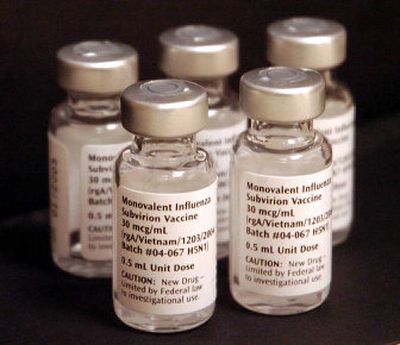Flu pandemic plan includes rationing, travel restrictions

WASHINGTON – Front-line health care providers, vaccine plant workers, pregnant women, government leaders and people with high-risk medical conditions would be among those given first priority for vaccination if a deadly influenza pandemic breaks out.
Issuing its long-awaited pandemic response plan Wednesday, the Bush administration made clear that a flu pandemic could make it necessary to impose travel restrictions, shut down schools and businesses, quarantine cities and ban public gatherings.
The 396-page document sketches the federal public health response and urges state and local authorities to confront the issues that would arise during a super-flu outbreak. They include rationing precious vaccine and drug supplies; issuing quarantines and closing schools; where to house the sick and dying when hospitals become overtaxed; and how to ensure the delivery of food, water and essential services in the midst of a major societal breakdown.
“An influenza pandemic has the potential to cause more death and illness than any other public health threat,” the Health and Human Services Department plan grimly notes, estimating a worst-case scenario could hospitalize 9.9 million people and kill 1.9 million.
The government predicts a third of the population would be sickened, with school-age children having a 40 percent rate of infection. Outbreaks, lasting six to eight weeks and recurring in waves, could cause an economic toll exceeding $181 billion.
While public health officials can’t predict when the next pandemic will hit, they are eyeing with concern an avian flu that has raced through Asia’s fowl populations, leading to the slaughter of tens of millions of birds. The strain, known as H5N1, has sickened 122 humans, with 62 confirmed deaths so far.
The H5N1 virus has yet to make the leap to easy person-to-person transmission, and may never do so. But epidemiologists note that with an average three pandemics a century, the last in 1968, the world may be overdue.
The release of the pandemic plan came a day after President Bush outlined a $7.1 billion preparedness proposal that focuses in large measure on stockpiling anti-viral medications and speeding vaccine production technologies and capacity.
The federal plan seeks to tame what would be a massively complex response, which in some cases would be led by the federal government, in others by local or state officials. Federal authorities stressed Wednesday, however, that much of the response would need to be shouldered by local and state authorities.
Public health officials around the country welcomed the federal plan’s release but complained that only $100 million of the $7.1 billion in proposed spending is earmarked for state and local public health departments. They also questioned the plan’s reliance on the states to buy enough anti-virals to treat 31 million Americans – a $510 million cost.
Some lawmakers complained that cash-strapped states are not in position to come up with the funding. Sen. Patty Murray, D-Wash., noted that the president’s 2006 budget calls for cuts of $130 million for state and local health departments.
“They are already struggling,” Murray said. “So if we add this on top of them … we are going to have a public health crisis. And that concerns me greatly.”